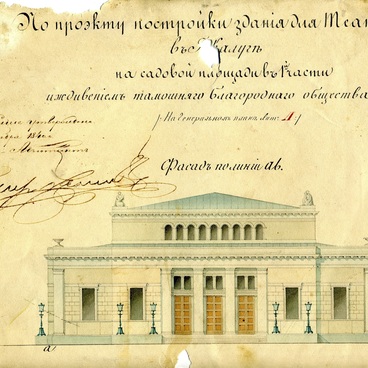In the Orthodox tradition, an antimension is a corporal made of silk or linen with small relics of a saint or a martyr sewn into it. It is an indispensable element of the divine liturgy.
An antimension is essentially a portable church table. The Lord’s table in the Russian Orthodox Church is the main sacred element of the altar, a quadrangular table that symbolizes the Throne of God. The Lord’s table is the place of the most important divine service, the liturgy. If a priest is unable to administer a ceremony in the church, he uses an antimension.
The exposition presents the antimension dating back to the period of reign of Catherine II of Russia. The central part of the corporal shows an episode called The Entombment, while in its corners, there are symbols of the four evangelists, St. Matthew, St. John, St. Mark and St. Luke, depicted in circles with ornamental elements. The inscriptions in Church Slavonic are made in ink.
The word antimension originates from the Greek and can be translated as instead of the table. In the Russian church, antimensions were first used during the reforms of Patriarch Nikon. The first corporal in Russia was made in 1148 for St. George’s Cathedral in Yuryev-Polsky.
Traditionally, one of three episodes was depicted on an antimension. The first was the image of Christ after death with angels next to Him and the Cross behind Him. The second type of image showed resurrected Christ sitting on the Tomb, and the third one showed the Entombment. Antimensions could also have inscriptions alone. The text usually indicated the name of the church that owned the corporal and the date of its construction.
Later, antimensions with hand-written inscriptions were replaced by those with printed ones, which were first produced at the Moscow Print Yard. The final approved version of the antimension with printed images and inscriptions, the sample drawing and the verbal formula were presented by the Holy Synod in 1855.
In the early 20th century, when divine services were prohibited in many churches, the priest’s chest could serve as the Lord’s table. There are records describing how priests who were exiled to the Solovki prison camp in the 1920s and 1930s served the divine liturgy secretly. One of the priests stripped to the waist and lay down, and his body served both as the Lord’s table and an antimension. On it, a divine service was administered with cranberry juice and rye bread in the absence of wine and altar bread.
Back in 1655, the Council of the Russian Orthodox Church ordered all churches to have antimensions. This tradition is still observed today. The antimension can be touched only by the priest vestured for the Divine Liturgy.
An antimension is essentially a portable church table. The Lord’s table in the Russian Orthodox Church is the main sacred element of the altar, a quadrangular table that symbolizes the Throne of God. The Lord’s table is the place of the most important divine service, the liturgy. If a priest is unable to administer a ceremony in the church, he uses an antimension.
The exposition presents the antimension dating back to the period of reign of Catherine II of Russia. The central part of the corporal shows an episode called The Entombment, while in its corners, there are symbols of the four evangelists, St. Matthew, St. John, St. Mark and St. Luke, depicted in circles with ornamental elements. The inscriptions in Church Slavonic are made in ink.
The word antimension originates from the Greek and can be translated as instead of the table. In the Russian church, antimensions were first used during the reforms of Patriarch Nikon. The first corporal in Russia was made in 1148 for St. George’s Cathedral in Yuryev-Polsky.
Traditionally, one of three episodes was depicted on an antimension. The first was the image of Christ after death with angels next to Him and the Cross behind Him. The second type of image showed resurrected Christ sitting on the Tomb, and the third one showed the Entombment. Antimensions could also have inscriptions alone. The text usually indicated the name of the church that owned the corporal and the date of its construction.
Later, antimensions with hand-written inscriptions were replaced by those with printed ones, which were first produced at the Moscow Print Yard. The final approved version of the antimension with printed images and inscriptions, the sample drawing and the verbal formula were presented by the Holy Synod in 1855.
In the early 20th century, when divine services were prohibited in many churches, the priest’s chest could serve as the Lord’s table. There are records describing how priests who were exiled to the Solovki prison camp in the 1920s and 1930s served the divine liturgy secretly. One of the priests stripped to the waist and lay down, and his body served both as the Lord’s table and an antimension. On it, a divine service was administered with cranberry juice and rye bread in the absence of wine and altar bread.
Back in 1655, the Council of the Russian Orthodox Church ordered all churches to have antimensions. This tradition is still observed today. The antimension can be touched only by the priest vestured for the Divine Liturgy.



